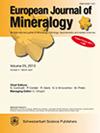伊比利亚西北地块的辉长岩、辉长岩和相关花岗岩对比:对地幔和地壳来源的洞察
IF 1.7
3区 地球科学
Q2 MINERALOGY
引用次数: 0
摘要
摘要碰撞后富镁钾基性岩石及其伴生花岗岩类在大多数造山带中有规律地出现。它们与评价地幔在花岗岩类成因中的作用,从而评价大陆地壳本身的作用有关。瓦里斯坎伊比利亚地块中最具特征的镁钾基性岩石是斜长岩和辉长岩。对比了两个来自伊比利亚西北部的花岗岩类,评估了它们的地幔和地壳来源以及它们形成过程中的岩浆过程。与之相关的花岗岩类有渐长岩、花岗闪长岩和二长花岗岩。可用的全岩主要元素和微量元素组成,以及Sr和Nd同位素,以及新的Sr - Nd同位素数据,被用于这次比较。磷灰石-花岗岩组合为钙-碱性组合,灰泥质组合为钙-碱性向碱-钙过渡。伏格长岩中Mg、K、相容和不相容微量元素的富集程度高于斜长岩,稀土元素的分异模式也高于斜长岩。相关的花岗岩类也提供了类似的差异。由于不同俯冲型交代地幔的部分熔融作用,斜斑岩和凹辉长岩具有Sr和Nd的地壳同位素特征:斜斑岩为角闪尖晶石辉长岩,凹辉长岩为更难熔且更深的角闪云母+石榴石橄榄岩。这些基性熔体在上升和就位期间与同时期花岗岩类进一步相互作用。二长花岗岩是由偏辉生酸性麻粒岩部分熔融形成的,不排除变质沉积物的贡献和/或黑云母不一致熔融在与辉长岩有关的麻粒岩中的作用越来越大。辉锑矿岩浆与麻粒岩的同化与分步结晶过程可以解释闪长岩和闪长岩。这一过程在与辉长岩有关的花岗闪长岩中未得到证实。本文章由计算机程序翻译,如有差异,请以英文原文为准。
Contrasting appinites, vaugnerites and related granitoids from the NW Iberian Massif: insight into mantle and crustal sources
Abstract. Post-collisional Mg–K-rich mafic rocks with associated granitoids appear regularly in most orogens. They are relevant to evaluate the mantle role in the genesis of granitoids and thereby of the continental crust itself. The most characteristic Mg–K mafic rocks in the Variscan Iberian Massif are appinites and vaugnerites. Two examples with associated granitoids from NW Iberia have been compared to assess their mantle and crustal sources and the magmatic processes involved in their formation. Related granitoids are tonalites, granodiorites and monzonitic granites. Available whole-rock major and trace element compositions, as well as Sr and Nd isotopes, were used for this comparison, along with new Sr–Nd isotopic data. The appinite–granitoid association is calc–alkalic, whereas the vaugneritic one is calc–alkalic transitional to alkali–calcic. Vaugnerites are more enriched in Mg and K, compatible and incompatible trace elements and display more fractionated rare-earth element (REE) patterns than appinites. Associated granitoids provide similar differences. Appinites and vaugnerites have Sr and Nd crustal isotopic signatures resulting from partial melting of a different subduction-type metasomatised mantle: amphibole spinel lherzolites for appinites and more refractory and deeper amphibole phlogopite ± garnet peridotites for vaugnerites. Further interaction of these basic melts with coeval granitoids occurred during their ascent and emplacement. The monzonitic granites derived from partial melting of metaigneous acid granulites, without discarding contribution of metasediments and/or an increasing role of biotite incongruent melting in those related to vaugnerites. An assimilation with fractional crystallisation process between appinite magmas and granulites could explain tonalites and granodiorites. This process was not confirmed for granodiorites related to vaugnerites.
求助全文
通过发布文献求助,成功后即可免费获取论文全文。
去求助
来源期刊
CiteScore
2.80
自引率
9.50%
发文量
40
审稿时长
6-12 weeks
期刊介绍:
EJM was founded to reach a large audience on an international scale and also for achieving closer cooperation of European countries in the publication of scientific results. The founding societies have set themselves the task of publishing a journal of the highest standard open to all scientists performing mineralogical research in the widest sense of the term, all over the world. Contributions will therefore be published primarily in English.
EJM publishes original papers, review articles and letters dealing with the mineralogical sciences s.l., primarily mineralogy, petrology, geochemistry, crystallography and ore deposits, but also biomineralogy, environmental, applied and technical mineralogy. Nevertheless, papers in any related field, including cultural heritage, will be considered.

 求助内容:
求助内容: 应助结果提醒方式:
应助结果提醒方式:


